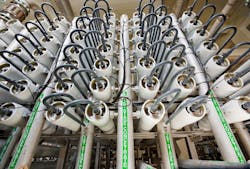Certification Action Line: Reverse osmosis
1. True or False: When osmotic shock occurs, it does not directly affect the membrane.
2. True or False: Reverse osmosis (RO) requires greater feed pressure than ultrafiltration.
3. True or False: In laboratory use, it is not particularly unusual to find the same water treated by ultrafiltration, RO and deionization (DI).
4. True or False: The advantage of presoftening an RO feedwater containing hardness is the reduction of membrane fouling.
5. True or False: In RO, the membrane is synthetically produced to have specific properties.
6. True or False: The oxygen content of water has an adverse effect on the RO process.
7. True or False: The rejection percentage is the percent of water going to waste in an RO unit.
8. True or False: Since RO does not require regeneration like DI, it is the best method for producing the highest-quality water.
9. True or False: RO rejects all mineral ions on the same percentage basis.
10. True or False: Higher feedwater temperature improves the rejection rate (percent rejection).
1. False. Osmotic shock involves sudden shrinkage or swelling of the membrane.
2. True. There are line pressure RO systems, but it is usually true.
3. True. Such as pharmaceutical water treatment.
4. True. Presoftening will help reduce buildup of calcium carbonate and calcium sulfate on the membrane.
5. True. Semipermeable membranes are manufactured from organic substances: cellulose acetate, cellulose triacetate or aromatic polyamide resins.
6. False. Oxygen is a dissolved gas and does not in and of itself affect the RO process.
7. False. Percent rejection = TDS in feed – TDS in permeate × 100 TDS in feed
8. False. RO is a physical separation of impurities. DI is more a chemical reaction (ion exchange), which produces a higher-quality product water.
9. False. RO is selective: different minerals, different percent.
10. False. Temperature affects the (permeate flux) product flow rate but does not significantly affect the permeate quality.
